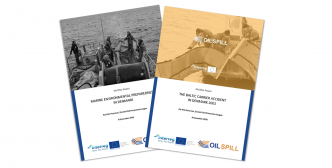
Read Kia Friis Petersen’s Blog Series on Oil Spill Response in Denmark as e-Booklets!
This autumn, Kia Friis Petersen from the Danish Civil Protection League wrote two interesting blog series related to oil spill response in …

This autumn, Kia Friis Petersen from the Danish Civil Protection League wrote two interesting blog series related to oil spill response in …
In the previous articles, the facts of the greatest oil spill in Danish waters were presented. 2,700 tonnes of oil leaked from the bunker ship Baltic Carrier on 29 March 2001 near the island of Falster, Denmark. For two weeks, Danish, German, and Swedish authorities cooperated to contain and collect the oil on sea and in shallow waters. In the following months, the affected municipalities continued the cleaning operation on the shores. By the end of July 2001, a total of 10,750 tonnes of oil and oil contaminated material had been collected. But is there more to the story?
An oil spill drifting into a narrow belt will most likely not hit the shore in one place – but in several places. And that is exactly what happened when oil from the Baltic Carrier drifted into the Belt of Groensund in the evening on 29 March 2001.
“The oil was so thick − like tar − that you could almost walk on it” – Peter Søe. It was not easy to remove the 2,350 tonnes of heavy fuel oil from the sea, shallow waters, or shores. Many people and an enormous number of wellingtons, waders, and shovels were needed in the operation.
Large-scale oil spill disasters are – luckily – relatively rare. But when they do happen, the existing knowledge, skills, and procedures are …